

Napoleonic Wargame Club
Newsletter
Edition 13 - March 2001
| Publisher: Pierre Desruisseaux | Editor: Ken Jones, British Army |
Associate Editors: |
|
| Rob Hamper, Prussian Army | Tom Simmons, French Army |
![]()
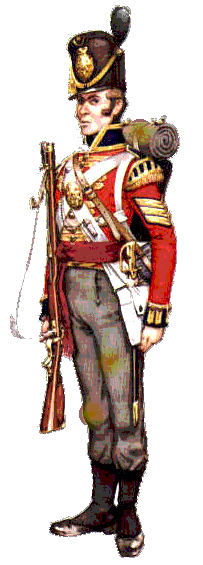
In this Issue ...
Dear Members:
The muddied British Cavalry officer rode his noticeably tired horse to the stable behind the Rhine Tavern. There he watched as a stable boy unsaddled his horse and began to water and groom the steed. The British officer sighed in satisfaction and turned to lift his bagscontaining the latest dispatches from the front. He headed for the Tavern's rear entrance and thought ahead to the fluid spirits that would ease his aches and pains from his days in the saddle and the comraderie he always enjoyed when he entered this soldier's refuge. The war was beginning to wear on him, though. Taking a toll that was not all physical and that could not be completely erased by a few rounds of drinks. Complicating things were matters concerning his growing personal estate back in Wales. Funny, it had been so long since he was home, he wasn't sure he would recognize the place. Still, he was sure he could juggle his obligations to King and Country and those of his estate if he could just reduce some of his administrative duties with the army. And so, after entering the Tavern proper and imbibing in the standard round of drinks and good cheer, he announced to those at hand, that after two years in the post, he was stepping down as editor-in-chief of the NWC newsletter. He could continue as an associate for a time (to help with the transition) but gradually he would need to remove himself from the operations, but for an occassional submission. So, he noted, the NWC Cabinet Ministers will be looking for someone to step forward and volunteer for this honorable post.
Editor Wanted!
Yes, its true. Effective immediately I am no longer editor-in-chief of the newsletter. The post is now open. I trust one of the members will step forward and continue, what I hope has been, a much anticipated publication. Perhaps one of the new recruits has some publishing skills. I was, after all, only a young Captain with no knowledge of web page editing or HTML code when I assumed these duties. I will be posting a Wanted sign in the Tavern to advertise the position. Everyone please give it your due consideration.On the battlefield, the French armies have kept the upper hand for the months of November, December, and January. In those three months the French recorded 41 major victories and 8 minor victories compared to the Allied Coalition's 36 major victories and 6 minors. The Arme du Rhine was particularly impressive with 22 major wins and a 53% won/loss ratio. For the Allies, the Russian Army turned in a stellar performance, winning 15 of 24 games for a won/loss ratio of 62 percent. On a game-by-game basis, the Russians showed a mastery of NIR with 13 major wins versus only 6 defeats. The Russian officers were rarely found outside their home turf, however (nothing like that fanatic morale). The Grande Armee, in contrast, posted a perfect record at Battlefield Elyau, winning every game played (3) by a major victory. They also posted a winning record against the Allies in PTW. For a complete breakdown of game stats for these three months
click here.Elsewhere around the club, the Allies finally finished up their fall tournament. A total of 20 games were started but only 11 of those were completed before the time limit (twice extended) expired. The results were: Prussians/Russians/Austrians/Spanish -- 10 wins; Anglo Allied -- 1 win ! Quite conclusive I think. For a complete break down of victors and vanquished please visit the tournament site at :
[The allied tourney website]. Thanks to Archduke Bill Peters and Maj. Gen. Tony Dobson for sponsoring this affair. Special thanks to Bill Peters who recently resigned his commission. His contributions to these events and elsewhere around the club will be greatly missed.The Westphalian tournament, that long and arduous campaign game brought to you by Erik Frederiksen (alias Davout), has ended in a stalemate. The initial French invasion was well met by the Allied Coalition and after a series of fights neither side was able to grasp an advantage. For a complete wrap-up of the campaign, visit the campaign website [
Click Here], or if that doesn't work [Click Here]. Toasts again to Erik for all the work he put into that gaming experience.In keeping with the club's fighting tradition, I have been asked to announce a challenge match between the much heralded Armee du Nord and the Anglo-Allied's famous 6th Infantry Division. The challenge features 8 matches between the opposing army organizations. For more information [
click here].And finally, I am pleased to announce that the NWC has started its own scenario library. Thanks to Master Librarian, Majoor Marco Bijl,
marco@nvforest.com, club members will have a convenient place to browse new scenarios and post some of their own. Visit the NWC Scenario Library by [clicking here]. Major Bijl assures me that links to the site will soon appear on the club's home pages and elsewhere.In the meantime, there are plenty of battles to be fought. Enjoy the camaraderie, keep your honor intact, and heed the wisdom of Sun Tzu, who said, "Know your enemy, know yourself; then your victory will never be endangered. Know the ground, know the weather; and your victory will then be total."
Tally Ho!
Your Humble and Obedient Servant,
K. Jones, Editor
Strategy and Tactics | Dispatches | Regimental Histories | On the Internet | Letters to the Editor

In this Issue ...
The International Napoleonic Fair
21 January 2001
by Bill Peterson
A drizzly Sunday in London witnessed the remarkable spectacle of over a thousand enthusiasts thronging the Royal National Hotel, sharing the various angles of their enjoyment of that 18th-19th Century era we call the "Napoleonic." Part stage-show, part emporium, part demonstration/exhibition, part meeting-place, part recruiting-station, it was all pleasure and carried on in the best of spirits. Three NWC members (Jon Brewitt, Jean-Denis Martin, and your correspondent, all coincidentally of the Grande Armée) met there to share meals, exchange anecdotes, and pose for a photo.
The stage-show aspect featured a superb lecture and question-and-answer session with Bernard Cornwell, author of the Sharpe novels. We all know what a fine writer he is, and how he transports us in imagination to the scenes of history. The pleasant discovery on meeting him in person is that he is an excellent raconteur and a warm, witty, personable and friendly guy. A second lecture was given by Digby Smith, the respected author of The Greenhill Napoleonic Wars Data Book, Napoleon's Regiments, "The Russians at Borodino" in The Napoleon Options (edited by Jonathan North), and (under the nom de plume Otto von Pivka) ainNavies of the Napoleonic Era and others. Digby spoke on the subject of his latest book, 1813: Leipzig. Like his books, the talk was bursting with enough information to make your head spin. The third stage-show was the Napoleonic Association Quiz Challenge Cup, of which more later.
The emporium
was and always has been the heart of the Fair, bringing together dealers in books and
paraphernalia with eager customers. Featured vendors were:
· Aldershot Badge & Medal Company (replica swords, badges, and insignia) www.militaria.co.uk
· Alix Baker Military Art (calendars, prints, postcards, paintings) www.alix-baker-militaryart.com
· Battlefields Review (bimonthly magazine aimed at battlefield visitors--like your correspondent!) Wharnecliffe Publishing Ltd, The Drill Hall, Eastgate, Barnsley, S70 2EU, UK
· Battlescene Pictures (military art) 14 Norwood Drive, Brierley, Barnsley, South Yorks S72 9EG, UK Bonapart history) 14 Rue Seguier, 75006 Paris, France
· Bonaparte's (military figures, books, prints) www.bonapartes.co.uk
· Caliver Books (pre-1914 military history) www.caliverbooks.demon.co.uk
· Coverart (original artwork commissioned for book covers, including Sharpe novels) Westfield Farmhouse, Woodhouse Road, Quorn, Leics LE12 8ED, UK
· Ian Fletcher Battlefield Tours (escorted battlefield tours plus book and figures shop) enquiries@ifbt.co.uk
· Greenhill Books (quality publisher & distributor of military history books) www.greenhillbooks.com
· W.E Hersant Ltd (military history booksellers) www.herbooks.dircon.co.uk
· Peter M. Holes Fine Books (fine books, exclusively Napoleonic) www.boneybooks.com
· Kennington Miniatures (manufactures of 20mm military figures) 4 Church Vale, Forest Hill, London SE23 2 UW, UK
· Le Cimier (historical figurines and prints) www.lecimier.com
· Librairie Hitorique Teissedre (books on French & military history) 14 Rue Seguier, 75006 Paris, France
· Gerald Lowthin (author of The Eagle, historical novel of the Peninsular War) 27 Allen House Park, Woking, Surrey GU22 0DB, UK
· Paul Meekins Books (Napoleonic and English Civil War books) www.paulmeekins.co.uk
· Military Fine Arts (mitary art) 5 Feversham Road, Salisbury, Wilts SP1 3PP, UK
· Military Illustrated (military history magazine) 39 Store Street, London WC1E 7DB, UK
· Old Glory Corporation (15 mm and 25 mm military figures) Institute House, New KYO, Stanley, Co Durham DH9 7TJ, UK
· The Old Guard (books, French 1st Empire antiques) P.O. Box 163, Braunton, Devon EX33 2YF, UK
· Phoenix Books (secondhand military history books) Holly House, 315 Lea Road, Gainsborough, Lincs DN21 1AR, UK
· Pireme Publishing Ltd (miniatures rules, boxed sets) Suite 10, Wessex House, St Leonard's Road, Bournemouth, Dorset BH8 8QS, UK
· Spellmount Ltd (ppublishers of military history books) www.spellmount.com
· Ken Trotman Ltd (leading distributor and publisher of military books) E-mail: Trotman@netcomuk.co.uk
· Robin Turner (napoleonic and pre-1914 bookseller) E-mail:robinturner-donovan.co.uk
· Turner Donovan Military Books (military history bookseller) www.turner-donovan.co.uk
· World War Books (military history bookseller) E-mail: wwarbooks@btinternet.com
· Worley Publications (publishers of
Napoleonic books and memiors) 10 Rectory Road
east, Felling, Tyne and Wear, NE10 9DN, UK
The demonstration and recruitment sides of the Fair included beautiful miniatures recreations of the Battle of Assaye (Wellesley in India, 1803), Leipzig 1813, and Trafalgar 1805. Splendidly attired re-enactors were encountered at every turn: Polish Lancers, French Carabiniers, Redcoats, the 21ème Régiment de Ligne, a ragged fantassin of the 1796 Armée d'Italie, and Sharpe's own 95th Rifles — all recruiting for their respective regiments.
The day's finale was The Napoleonic Association Quiz Challenge Cup, pitting panels of researchers, historians, wargamers, and re-enactors against each other in a brain-busting test of Napoleonic knowledge. Your correspondent managed to scribble down most of the questions. How would you fare with these? (Answers published separately.)
1) Where and when did Wellesley first land in Portugal?
2) What is the French name for the band instrument the English call "Jingling Johnnies"?
3) What battle did Wellington consider his greatest achievement?
4) Which French Marshal was most respected by Wellington?
5) What war was ended by the Treaty of Ghent?
6) What important event in Napoleon's life occurred on 9 March, 1796?
7) What Marshal was also the French Minister of War from 1801 to 1807?
8) What was the title of nobility of the Lennox family, significant in the Waterloo Campaign?
9) Which battlefield includes the Goldbach valley?
10) What is the French term for what the English call the "Forlorn Hope"?
11) What French Marshal was removed from his post in the Peninsula "for cause"? Why?
12) Who were the "Belem Rangers"?
13) In French, "ragusier" means "to betray." Why?
14) Napoleon was imprisoned in 1794. Why? In what prison?
15) Who was nicknamed "Cleopatra"?
16) What French General escaped from captivity in Nottingham in 1812, in time to join the invasion of Russia?
17) Who was the commander of the besieging force at San Sebastian, 1813-14?
18) What is a "Brown George"?
19) Who commanded the French forces in Ireland in 1798?
20) Which of the Bonaparte brothers settled in America?
21) What was the French nickname/epithet for Englishmen?
22) Who were the "Jonathans"?
23) How many Marshals were appointed by Napoleon? Who was the last named?
24) Who was originally known as Marie Tascher de la Pagerie?
Give Up? Click Here for Quiz Answers
Hope to see many of you at next year's Fair. The Fair is held annually, ususally in February (see www.greenhillbooks.com for details).
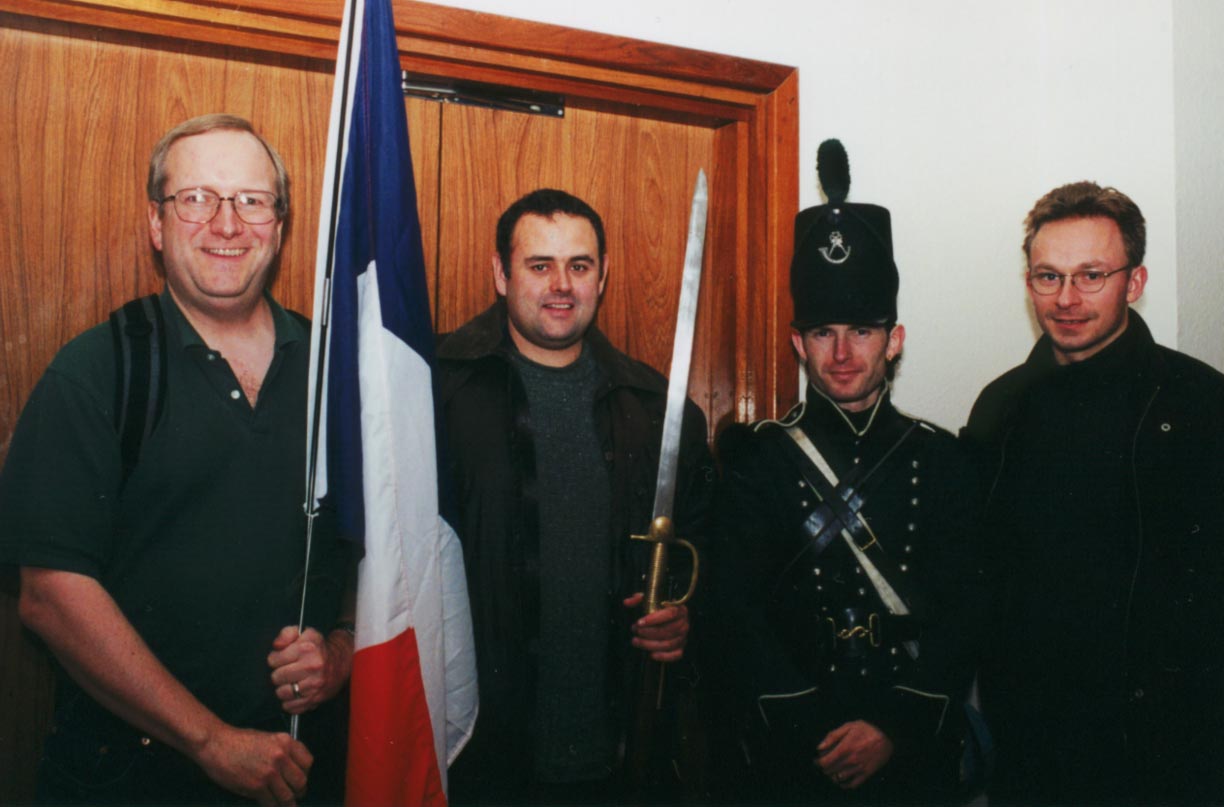
Caption: Bill Peterson, Jon Brewitt, and Jean-Denis Martin of the Grande Armée, NWC, with a member of the 95th Rifles. International Napoleonic Fair, London, 21 January 2001.
Interview with Stephane Chicouri
with Jean-Denis Martin

Editor's Note: For those who don't know, Stephane Chicouri is a fellow gamer, a member of the NWC and is webmaster of his own site, 'The Napoleonic Warfare' (TNW), a.k.a. Cobexlaw, where he displays his great artistic talent in creating new unit icons, new battles, and smaller scencarios for Battleground and other Napoleonic games. Stephane also does a great service by making all his work available for free. His site is found at [http://www.cobexlaw.com/wargame/wargame.htm].
Stephane, tell us a little bit about yourself:
I live in Paris, I am lawyer, 37 years old. I have no programming experience at all. I got into gaming when I was a child.
When did you start playing BG games?
As soon as the games were available in shops. I used to play cardboard games first. My favorite was SPI's « WELLINGTON'sVICTORY » (me too). But it was a huge game that needed a lot of space. I developped extensions for it too, closely resembling what I am doing now, but on cardboard. I had several thousand counters showing every army, several dozen maps, etc.
You have set up a web site dedicated to enhancing the BG series, tell us more about it
I understood very soon that all BG games had something in common and are close to WELLINGTON'S VICTORY. So, I decided to apply my cardboard adaptations to it, and to do it in the same way.

First, I divided the Napoleonic era into several periods, that I called « Volumes ». The division is not arbitrary, it is delineated by the different coalitions of enemies against France, but also upon major changes in uniforms and army organisations or reorganizations.
Each volume has common files that can be used to play any campaign within that period, mainly unit files.
Each volume is provided with a big order of battle file « main.oob », including nearly all armies of every country involved in the war, with its own organisation. The units are displayed at full theoretical strength. Artillery units have different fire values based upon their type / caliber etc.
Current site contents

So the volumes are :
Volume 1 : 1805 to 1807
Volume 2 : 1808 to 1811
Volume 3 : 1812
Volume 4 : 1813-1814
Volume 5 : 1815
Volumes are always evolving though, they will never be finished, and many more battles will be added. But the scheme is complete, so I have now more time to focus on doing more battles.
This order of battle can be used as such, or as a basis to get information from it to make new files, specially if you use the Dominik DERWINSKY order of battle editor also available on the site.
Beside that, there are some battles and scenarios available, both original ones (La Corunna, Gunzburg, and some « what if » scenarios), and adaptations of existing extensions (Eylau, Pultusk, Aspern, etc.). Also there are some adaptations of the original BG files that can be used to play the original games with new units (WATERLOO, PRELUDE TO WATERLOO, BORODINO).
In my OOBs, each country has its own graphic units, showing its own uniform with its own flag and background colour. Most of the time, each regiment has its own uniform showing its facing colour (when the information is available of course).
I don t claim the units are 100% accurate, but 90% accuracy is close.
What is involved in putting together the unit.bmp files? Where do you get your information?

I am always trying to maintain and update the files. I think it is important to keep the interest of gamers and a good level of quality. I spent nearly 5,000 dollars for the purpose of that site, and that doesn't count the hours in shops, in flee markets, and elsewhere trying to find old postcards, old pictures, or talking with some illustrators. One of my pictures was given to me by an illustrator that made it for the box cover of a figurine model. I actually had this picture and developed the icon before the figurine and the illustration were available in shops.
Have you done this all by yourself or have you had any help?
I don't have a lot of help, most of the work is a lonely venture. Only recently John Rice from the NHWC club did contribute some concrete work. John made the 3-D map for Gunzburg, flags for russian units, and terrain tiles for Corunna. Al Amos has also helped some. Al is specialist in scenario making. Maybe I forget some minor participations and I apologize for it.
What is the most difficult part of putting together a new scenario? The map? The units?
The units are most difficult, because painting them requires precision. But it is also the most pleasant part, so I don t feel the pain! It is difficult to make new battles. It is not enough to just throw units on a new map, you have to carefully study the battle so players have a feeling it is realistic, not just a kind of ordinary butchery on another map. So it takes time and a lot of work if we want to acheive a good quality.
What's in the pipeline?
Currently I am working on the 4th generation of pictures, and all my units files will be improved soon.
Also, there are rumors of a new game to come quite soon, and I want to wait for it a little. With that in mind, I am preparing AUSTERLITZ, maybe TALAVERA, but there is such a project already.
And I am working on Volume IV - 1813-1814.
How doess your works compare to say the NIR Project? Are they compatible?
I made some scenarios and several hundred pictures for nirproject. It does not compare, because from the beginning, I organized my files into Volumes 1-5. Only recently did nirproject adopt that approach. The problem is that no games are compatible with someone else's. The whole game system is quite old and thus has some limitations.
Do you play test games for any commercial designers?
I am testing a new game from a French designer on AUSTERLITZ. 3D isometric, very different from Battleground.
Thanks Stephane, not only for the talk but also for making all your work available to gamers around the world.
interview by:
Jean-Denis Martin,
III Corps, AdN


The French Occupation of London
By Bill Peterson & Friends
Click on the picture for a rollicking adventure through London with these French Conquerors
The Front Page | Feature Articles | Dispatches | Regimental Histories | On the Internet | Letters to the Editor
A
general-in-chief should ask himself frequently in the day, What should I do if the enemy 's army appeared now in my front, or on my right, or on my left? If he have any difficulty in answering these questions he is ill posted, and should seek to remedy it.Napoleon's Maxim of War IX
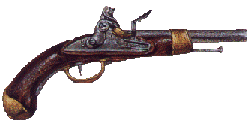
In this Issue ...
MPP006 is a custom "Monster" MP scenario (77 Turns!) depicting a "what if" situation for PTW Twin Battles. The entire Armee du Nord, including units detached prior to the start of the Waterloo Campaign, is available for deployment by the French team at the outset. They face the combined armies of Wellington and Blucher. This article describes the opening hours of the battle.

La Bataille de Quatre Bras - Part II:
Or
The Death of General AltenLt. J. S. Tessier, 1er Carabinier (game moderator)
[Editor's Note: Unfortunately, Monsieur Tessier has been fairly busy and was not able to file a complete report on the game's progress this quarter. However, there have been certain developments that I will try to pass on].
First, the present situation is this: The French, after a slow start, have driven in the Allied left flank and have taken the woods and heights above the Etang Materne (see picture below). In so doing, they severely thrashed General Ompteda's 2nd KGL Brigade -- killing both General Ompteda and General Alten, the commader of the Allied 3rd Division. After seizing the strategic high ground, the French paused only breifly before Marshal Ney sent a strong force of cavalry and infantry on a wide flanking maneuver in an attempt to get behind the Allied left and sieze the crossroads. The Allies have responded to this maneuver by pulling together the remnants of their left flank and sending cavalry to piquette the roads to the east of Quatre Bras.
Elsewhere, the Duke of Brunswick's men have just about driven the French forces from the Bossu Wood and are now pressuring the French left. They have been assisted in this effort by the 1st and 2nd Brigades of General Chasse's 3rd Dutch/Belgian Division who have been positioned in the rye between the wood and the main north-south road to Quatre Bras. A couple of French artillery batteries, positioned on the heights that extend out from the Bossu Wood just south of the little stream that runs from west to east and passes in front of the Gemincourt Farm, have been firing with good effect and have so far held General Chasse's advance in check.
So now, with barely more than two hours of game time remaining, the outcome still hangs in the balance. The French are threatening the strategic crossroads from the east while the Allies are pushing through the Bossu Wood in an attempt to drive in the French left. Casualties for both sides are relatively modest. The Allies have lost about 4600 infantry, 100 cavalry, and 2 guns while the French have suffered 4500 infantry casualties and about 300 cavalry. Who will succeed? Check this space next issue for the answer.
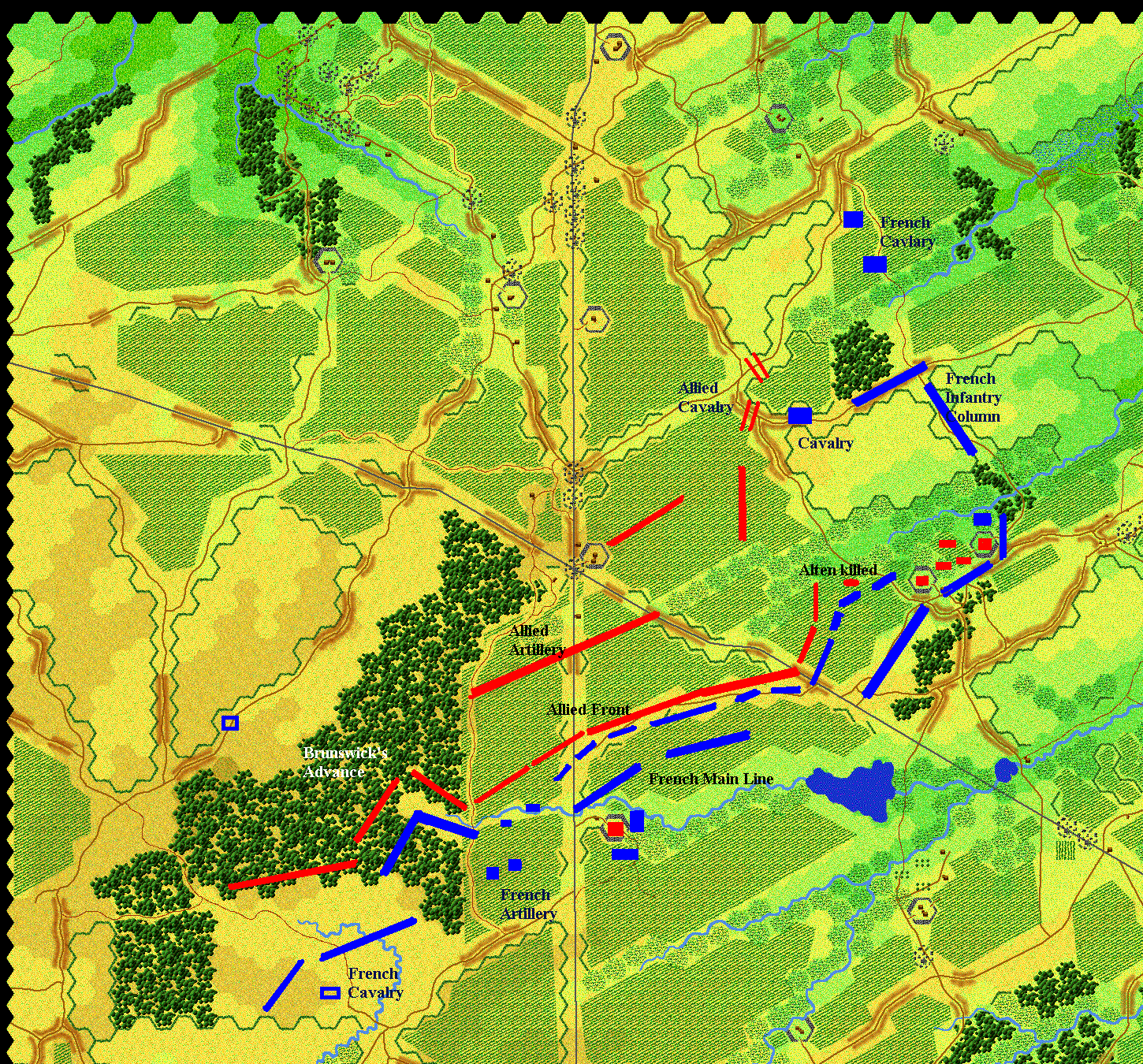
Wait, a dispatch has just arrived from the field ...
To: Jean Tessier and the Allied Command
Subject: Death of General Alten
Date: Thu, 01 Feb 2001
Gentlemen,
I have just been notified of my death.
What follows is a copy of my
After Action Report which I am circulating for your general amusement. It only contains historical information and so should not infringe any of the communication rules. When the game is over I shall be interested to read of your own experiences and compare notes.After Action Report : Quatre Bras
Sir Charles Alten, Dec'd (alias David Hatch)
A Bad Start
There can be no doubt that this game got off to a bad start for me. With the best intentions I decided to do what I believe to be the historically accurate thing and gallop ahead of my troops to determine the lie of the land and my superior's intentions.
Unfortunately! This proved to be totally counterproductive on three counts:
1. It appears my superiors were as confused as I was and so no insight was gained into what their plans were and when I attempted to press the point I was politely told by Wellington 'go away'. Which, having since read Mercer's Journal, is precisely the response he got when he tried to have a similar conversation with Vandeleur on the approach to Quatre Bras. So, perhaps the incident was quite historically accurate.
2. It was also clear that the benefits of IPVM orders were not fully appreciated by my fellow players and so instead of giving us an opportunity for an in-depth planning session my personal visit to the boss merely used up valuable time.
3. When I left my Division I had assumed that my subordinates would continue to carry out their orders to march on the crossroads. I, therefore, estimated that I had about an hour before they reached Quatre Bras, by which time I could rejoin them and issue fresh orders based on my enlightened knowledge having just spoken to the boss. Unfortunately, the umpire decided that in my absence my subordinates had gone into 'dumb-mode' and decided to stop for breakfast.
By the time I realized that I was not going to get any sense out of my superiors and that my men were no longer moving, but were in fact having a picnic, my Division had been delayed by at least half an hour. This delay was to prove critical during my Divisions subsequent deployment.
Stretching the Point Too Far
Anticipating the frustrations of having a third party deploy and move my troops for me I had already issued detailed 'Standing Orders' to my division based upon the excellent description of British linear tactic's written by Jason Crawley. I had also issued supplementary instructions to my artillery and sharpshooters emphasizing the target priorities I expected them to consider when in action (I didn't want them popping off ammunition firing at enemy skirmishers).
Under the normal conditions of deployment a Division of my size would only be able to competently cover a frontage of seven hexes (1400 paces). Unfortunately, the frontage I finally found myself ordered to cover extended from the main
Brussels-Chausee road to Basse Cense Farm -- a distance well over twice what should have been expected -- meaning that not only was my Division unable to deploy in the manner I had described but that it would be dangerously over extended.
At the time, this did not bother me too greatly as it was clear that the main French thrust was against Perponcher's Division to my right and I assumed that the Duke of Brunswick's Corps or Division Chasse would soon be moved up to relieve me of part of the front.
My Kingdom for Some Horse
Of more worry at this point was the fact that the French were clearly massing a Brigade of light cavalry on the Sombreffe Road and were planning to use this cavalry to turn my left flank. This information was reported to my superiors on more than one occasion, as were requests for cavalry support to dissuade the French Cavalry from making this move or to inhibit the movement of their infantry if they decided to try and exploit their advantage.
Unfortunately, my superiors did not share my concern about this situation and so no support was provided. Instead, the Prince of Orange ordered my Division to advance.
In fact I had already issued orders for my Division to advance but it was clear that the umpire was not going to allow any such movement whilst my infantry was under threat from the French Cavalry and my units stubbornly refused to move forward.
Eventually, I did manage to persuade my sharpshooters to ignore the enemy cavalry and occupy the wooded hill -- which was the key position on my left. For a while, at least, things seemed to be stable. The initial attacks of the French Chasseurs on Ompteda's Brigade were driven off with heavy loss and their lancers seemed content to linger en-potence rather than push the point any further.
It soon became clear, however, that the French Cavalry had called for support from their infantry and that, unlike my own pleas, their's had been granted. Soon a division of French infantry was closing rapidly on my position.
Realizing that I could not deploy effectively to meet their infantry whilst their lancers were poised to attack, I once more requested cavalry support so that at least their infantry would be under the same threat. Once again, however, the response from the Prince of Orange was merely an order for my Division to advance.
At the same time, it was clear that Perponcher's Division was beign forced to give ground. This left my right flank hanging in the air. Furthermore, The Duke of Brunswick, whose troops I was counting on to absorb some of my Division's over-extended frontage, seemed to have been sent on a nature ramble to the far side of the Bossu Woods. Hence, my Division was left over-extended and without support.
By now it was obvious to me that the initial thrust against Perponcher's Division had either been a feint or had been cancelled and that the main weight of the French assault had shifted to my flank. I had taken a calculated risk in trying to hide the weakness of my position by keeping my troops hidden from the French but it was clear that either this ruse had failed or the French had managed to deduce how thinly spread my position was, for I could now see a full French Division massing on the Sombreffe Road and another heading towards Halkett's Brigade which was positioned on my right.
Realizing that my Division would be unable to hold a massed column attack by two French Divisions with cavalry support, I contemplated ordering a withdrawal to a line from Haut Cense to Quatre Bras, but the imminent arrival of Division Chasse persuaded me to hang on a little longer in order to buy time for whatever plans my superiors may have had to materialize. At this time, I received yet another order to advance from the Prince of Orange.
Like a Knife through Butter
The anticipated arrival of the massed French infantry amongst my over-extended Division coincided with yet another dispatch from Prince William, informing me that I was not being attacked and was to advance immediately.
It also highlighted a major flaw in the Talonsoft game mechanic's. It was clear to me early in the game that the phasing used by the Battleground game system was hampering proper tactical control of my troops by creating a 15 minute phase of unreported enemy movement before a player had a chance to react. This was a particular problem for a defending player as it prevented him conducting a flexible defense by denying him any opportunity to react to the movement of the attacking troops in the vital minutes just before the clash of arms. There would be no opportunity for Wellington to do his 'Now Maitland, now's your time' trick in a game operating under these rules.
Presumably, though, the attacking players were suffering the same restriction. But, as the defending troops were not moving they could at least be reasonably certain that the line would still be where it was last reported. Whereas a French column could have moved 1000 paces in the time between the defending general issuing orders and their execution, even if the commander was with the unit. So Wellington would have had to shout the order for the Guards to stand up when the French columns were still crossing the valley and hope they didn't change course before they reached him.
In my opinion, this confirmed a suspicion I had held from the beginning: that the Battleground Game System is not really suitable for this sort of game. As the French columns closed with my Division it soon became apparent that this issue was going to be critical.
In my standing orders I had emphasized the importance of flexibility in Defense -- highlighting, in particular, that battalions were not to stand and wait for the French to close, but were to advance upon then as soon as the enemy's columns were within musket range and engage them at close range. This should have resulted in several battalions from both the first and second lines closing on the head of the French columns and blasting them with close range musketry as soon as they arrived within 400 paces of my position. However, because of the phasing, I was unable to order this explicitly and once the bullets started flying it was clear that any memory of my standing orders had melted away. Consequently, instead of a flexible defense my battalions were subject to a classic French column attack straight out of Napoleon's textbook. My men were left standing 'dumbly' whilst the French skirmishers racked up their fatigue and watched stupidly as French columns were allowed to march around and through the intervals between their battalions. What was doubly frustrating was that my Division was heavy in rifle-armed skirmishers that should have enabled them to easily drive off the enemy voltigeurs and inflict their own fatigue damage on the massed French Columns.
Once again the importance of deploying a strong skirmish line had been emphasized in my 'Standing Orders'. This skirmisher screen was supposed to be made up of the sharpshooters and light companies from all three Brigades operating en-masse. In action, however, the support battalions proved extremely reluctant even to deploy into line, let alone deploy their skirmishers until they were actually under fire and several became disordered before they were able to do so. In fact, some of the Hannoverian Field Battalions never deployed skirmishers at all making me wonder if they had been confused with Hannoverian Militia in the OOB.
Furthermore, those skirmishers which were deployed chose to collect in huddled groups in the intervals between the battalions of the front line instead of screening the main battle line. In their chosen position, their presence proved not only to be of no benefit, but it was actually detrimental to the position in that it negated the line battalion,s zones of control and gave the French columns the perfect justification for driving through these intervals into our rear.
Just to rub salt into my wounds, this then led to the front line battalions either routing or falling back in disorder directly into their supporting battalions, which because of their reluctance to deploy into line were still in column, thereby disordering both parties. Hence, the French were easily able to mass a whole Division against Halkett's Brigade and drive past it like a knife through butter throwing the reserve units from Keilmannsegge's Brigade into disorder at the same time.
Orders? What Orders?
Meanwhile Ompteda's Brigade was suffering from a combination of tactical paralysis and selective amnesia on my left. Before leaving them I had issued a number of IPMV orders to both Ompteda and his battalion commanders explaining the importance of seizing and holding the wooded hill to their front and garrisoning the farms of Haut Cense and Basse Cense. Despite initial reservations from a mysterious Corporal from the sharpshooters at the prospect of entering a wood that might contain French Cavalry, the skirmishers did advance. Their reservations driven off, no doubt, by my promises of large quantities of schnapps and the KGL line battalions had driven off the initial attack of the French Chasseurs a Cheval.
All of these troops had clear instructions of what was expected of them and where they were to deploy (including hex numbers). Some of these objectives could not be achieved immediately because of the attacks by French cavalry but these attacks were over soon after I left them to join Halkett. Thus, I expected to see the Brigade begin to carry out the orders I had left with them. Unfortunately, this didn't happen. Instead despite my orders:
1. The 1st & 2nd Light Battalions failed to reinforce their position on the wooded hill to their front. This not only allowed the French infantry to gain a foothold within the trees but also allowed them to occupy the actual positions I had specified on my map for my own troops.
2. The Field-Jager detached from Keilmansegge's Brigade also failed to provide a proper garrison for either Basse Cense or Haut Cense -- occupying both positions with only a single company and deploying the bulk of their force in a nearby orchard which had no strategic value and whcih was in direct contravention of their orders. Had I lived I had already decided that the commander of this detachment was to face a court marshal for this incompetence.
3. The 8th Line Battalion ordered to a position which would have prevented the movement of French troops along the Sombreffe Road also failed to do so and thus allowed free passage by a Brigade of French infantry into the Division,s rear. Doubly embarrassing because I hold a commission in this Regiment.
In short, Ompteda's Brigade not only failed to exercise a reasonable degree of initiative but actually ignored direct orders -- orders which would have secured the position and prevented the French from exploiting their position on the Sombreffe Road and gaining access to our rear. Despite the fact that I had foreseen this movement at least two hours before and had issued careful orders to prevent it.
When I questioned the umpire about the failure of my troops to obey my orders I was told that their reluctance was the direct result of confusion caused by orders being issued to them by other players which had overridden not only my orders but also their standing orders. Naturally, as a subordinate officer this was beyond my control. I really had no answer for that. [editor's note: this, I think, is an important point]
By now the situation was largely academic anyway. Ompteda's Brigade, denied the cavalry support it needed to negate the presence of the enemy cavalry, was driven off the wooded hill and caught in square by French infantry columns supported closely by artillery. Not surprisingly they broke and fled. The Field-Jager who should have been barricaded behind the loopholed walls of Basse Cense and Haut Cense were caught still picking apples in the orchard and so have no doubt also been driven off by now (editor's note: they still hold).
My End Cometh
In a last desperate attempt to stem the flood of French infantry I attempted to reach the square of the 5th Line Battalion, but, alas, was cut down and killed. My obituary should read:
Alas, poor General Alten, wounded, exhausted, and exasperated, succumbed to the tide of battle. His body, trampled by the bloody boots of his retreating men, was discovered by General Girard, who muttered a silent prayer for the vanquished hero.
I suspect that having broken through on our left the French will now storm on down the Sombreffe Road and capture the crossroads within the next hour or so. I noticed another fresh Division is already on its way from the direction of Marbais and I doubt that the Guards will be enough to stop them. I wish you all well and look forward to hearing of your own exploits later.
Regards ,
David Hatch
David Hatch (Lt.) NWC
The Front Page | Feature Articles | Strategy and Tactics | Dispatches | On the Internet | Letters to the Editor
Officers of the French and Allied armies! Welcome to our Regimental Histories section! Your researched biographies or regimental histories are hereby solicited for submission. If accepted, you may earn an award or mention in dispatches. At the minimum, you can join us for a flagon or two at the Rhine Tavern....our thanks go out to this month's contributors, with a special mention to artist Romain Baulesch for his kind permission to use the image (below) from Osprey Publishing's Campaign Series 33 by Ian Castle.
Click on the image to go to the Regimental History Section.
This month we present following regimental histories:
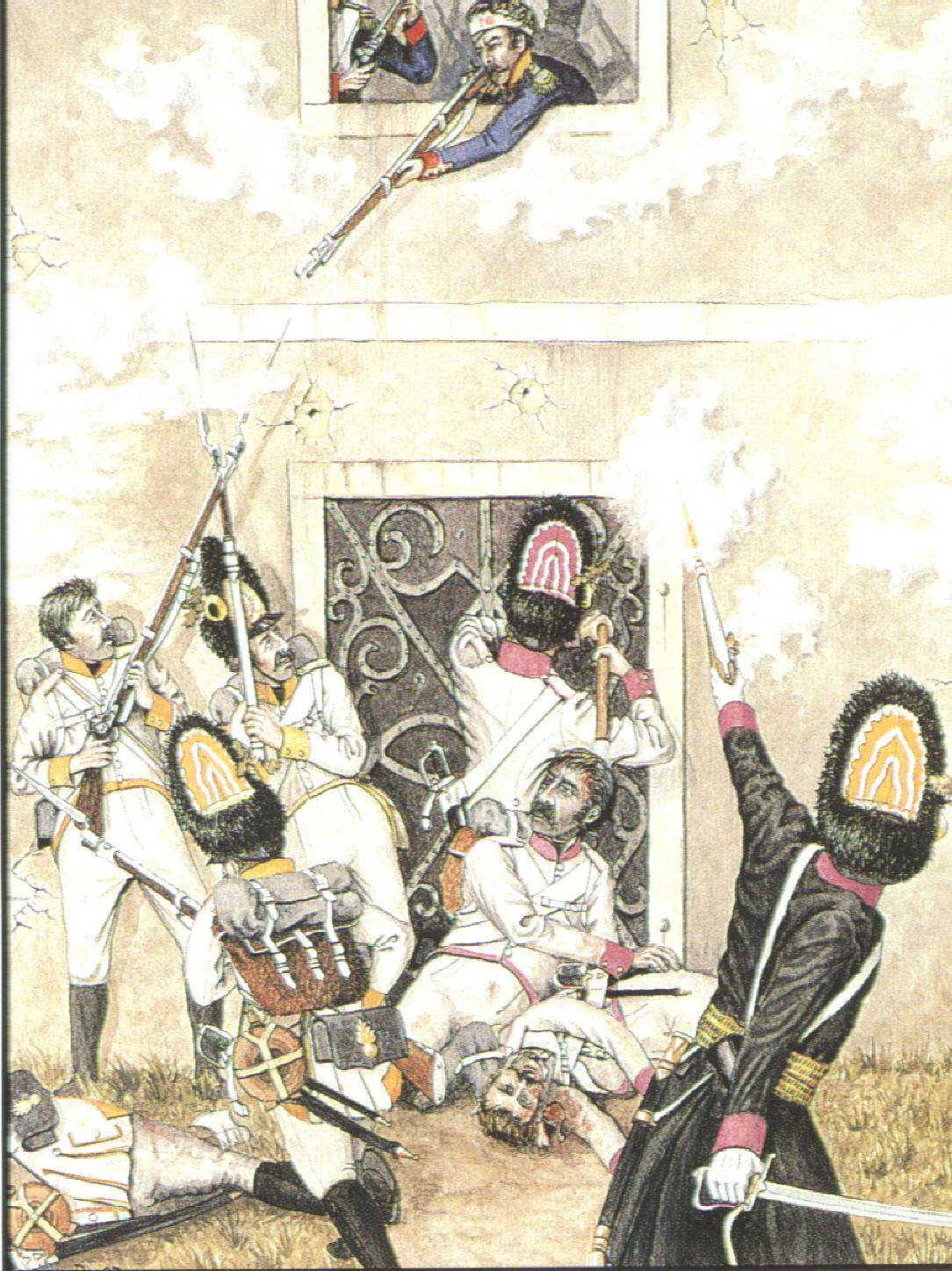
click on image to go to regimental histories
The Front Page | Feature Articles | Strategy and Tactics | Letters to the Editor
To act upon lines far removed from each other, and without communications, is to commit a fault which always gives birth to a second.
Napoleon's Maxim of War XI
Anglo-Allied Army | La Grande Army | Prussian Army | Russian Army | Austrian Army
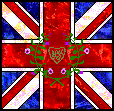
Gentlemen:
Below are listed the Army Orders for the month of August, following resignations and other commitments there has had to be a re-shuffle of the commanding officers of certain Divisions and Brigades, I would like to personally thank all those fellow officers who have contributed to the smooth running of this Army, when they feel they have the spare time to take command again, PLEASE do not hesitate to contact my Headquarters. Please take time to introduce yourself to your new commanding officer and visa-versa.
Army Orders
Lt. Col. Robert Thoyts to command of 4th Light Brigade
Maj. Gen. Sir Ken 'Muddy' Jones,
KG, honorary commission to Guards
Ladies and Gentlemen:
George, by the Grace of God, of the United Kingdom of Great Britain and Ireland, and of the British Dominions beyond the seas, King, Defender of the Faith, does hereby order the promotion of the following officers for their continued success against the French and for their diligent discharge of their duties:New Commissions
Lt. Tim Dodwin to Duke of Cumberland Hussars
Lt. Gregory Fedorenko to 81st Reg't of Foot - Loyal Lincolnshire Volunteers
Lt. B.W. Smith to 81st Reg't of Foot - Loyal Lincolnshire Volunteers
Cornet Pippen Henderson to Royal Horse Guard Blues
Lt. Jeff Wicks to 3rd Line Battalion, King's German Legion
Lt. John McCue to 40th Reg't of Foot
Cornet Jason Cooper to 2nd Dragoons
Lt. Martin Talyor to 2nd Line Battalion, King's German Legion
Lt. Jerry McKenzie to 1st Bn., 73rd Reg't of Foot, 11th Bgde., 6th Div.
Lt. Mark Rhodes to 22nd Reg't of Foot
Lt. Matthew Dawkins to 1st Bn., 61st Reg't of Foot, 11th Bgde., 6th Div.
Lt. Matthew Upson, 1st Bn., 7th Reg't of Foot, 12th Bgde., 4th Div., II Corps
Promotions
Lt. A. Hall to Captain
Lt. Mark Nelms to Captain; to Major
Lt. Michael Davies to Captain; to Major; to Lt. Colonel
Lt. James McLeod to Kapitein; to Major
Lt. Bob Breen to Captain
Capt. Marco Bijl to Major; to Lt. Kolonel
Capt. John Candlish to Major
Capt. Sergi Maymi to Major
Major Stefan Johansson to Lt. Colonel
Capt. Robert Thoyts to Major; to Lt. Colonel
Lt. Col. Douglas McKenzie to Colonel
Lt. Col. Phillip 'Butcher' Roubard to Brigadier General
Brig. Gen. Sir Ken 'Muddy' Jones,
KG, to Major GeneralBrig. Gen. Tony Dobson to Major General
Maj. General Rich 'Dutch' Holland to Lieutenant General
Ladies and Gentlemen:
George, by the Grace of God, of the United Kingdom of Great Britain and Ireland, and of the British Dominions beyond the seas, King, Defender of the Faith, does hereby bestow the following officers with awards for their services with the British Forces, their continued success against the French, and for their diligent discharge of their duties:
Medals and Awards
See the Allied Army Library Webpage for a description of each medal and why they are awarded.
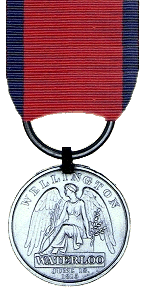
Waterloo Medal
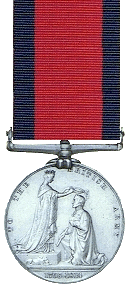
Military General Service Medal
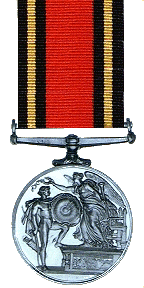
Army Best Shot Medal
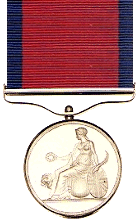
Army Gold Medal
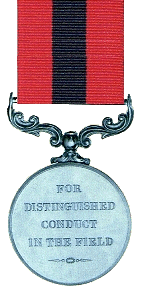
Distinguished Conduct Medal
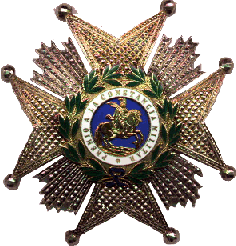
Order of St. Hermengildo
I have the honour to remain your humble & obedient servant
Paul Harris
Lieut General Sir Paul Harris
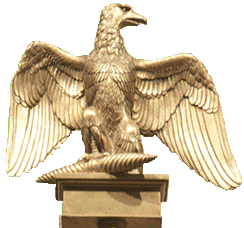

L'Armee du Nord
Jan 2001
Mon Generale,
My compliments and herein is submitted for your consideration l'Armee du Nord's Muster report for January, 2001.
I. Admissions/Promotions to La Garde Imperiale -
Special mention should be made of the following officers who have recently been admitted to the ranks of La Garde or promoted within it:
Lieutenant Colonel Rene Forster of the IIC has been granted admission into the Young Guard, where he will take command of the 1er/2e Tirailleurs and receive the title of Baron d'Empire.
Colonel Juan Antonio Rios Reviejo of the I Cav Corps has been granted admission into the Young Guard, where he will take command of the 2e Garde d'Honneur of la Cavalerie de la Jeune Garde and receive the title of Baron d'Empire.
General de Brigade Ian Weightman of the I Cav Corps has been offered the command of la 1er Brigade, 1er Division de la Jeune Garde. In recognition of this achievement, he has been elevated to Comte de Caen.
Lieutenant Colonel Guillaume Aymonier-Ameline of the IIIC has earned admission to la Moyenne Garde, where he will take command of la 1er Regiment de l'Emperatrice Dragons, 2e Brigade Lourde, Cavalerie de la Moyenne Garde. In recognition of this achievement, he has been elevated
to Comte de Strasbourg.
Colonel Tony Bovo of the IC has earned admission to la Moyenne Garde, where he will take command of the 1er Lanciers de la Garde (Polish Lancers). In recognition of this achievement, he has been elevated to Comte d'Amiens.
Colonel Hector Lopez of the IC has earned admission to la Vieille Garde, where he will take command of the 1er/ 1er Chasseurs a Pied.
II. Orders, Decorations and Medals -
HQ:
GdDv Palomo - Military Star for achieving five victories over the enemies of l'Empereur.
IC:
Colonel Tony Bovo - Military Star for achieving five victories over the enemies of l'Empereur and Croix deValeur for the elan he displayed in his recent "reverse maneuver" encounter with Maj. Amos of the Austrian Army;
Lt. C.R. Hopkins - Medaille Miliatire for his first Major Victory;
Lt. Allesandro Stoppa - Medaille Miliatire for his first Major Victory;
Col. Lopez - Military Star for achieving five victories over the enemies of l'Empereur;
GdBG John Mitchell - Military Star for achieving five victories over the enemies of l'Empereur and the St. Helena Medal for his distinguished service as the commander of the IC for the past year.
IIC:
Gen. de Brigade Einar J. Masson is recommended for the Order of the Iron Crown for his work on developing historical scenarios.
Lt. Ozols is recommended for the Medaille Militaire for his first Major Victory.
Major Simmons is recommended for the Medaille Militaire for his first Major Victory.
Baron Rene Forster is recommended for the Military Star for achieving five victories over the enemies of l'Empereur;
Colonel Jensen, Comte de Suchet, is recommended for La Legion d'Honneur 2nd Class ("Grand Officers") for his distinguished record of service to the IIC and Grande Armee and the Military Star for achieving five victories over the enemies of l'Empereur.
IIIC:
Maj. Worthington is recommended for the Medaille Militaire for his first Major Victory;
Capt Abruzzese is recommended for the Medaille Militaire for his first Major Victory;
Capt Rodriguez is recommended for the Medaille Militaire for his first Major Victory;
Col. Gatto - Military Star for achieving five victories over the enemies of l'Empereur;
LtC Aymonier-Ameline Military Star for achieving five victories over the enemies of l'Empereur;
Col. Martin - Military Star for achieving five victories over the enemies of l'Empereur.
I Cav:
Colonel Rios - Military Star Military Star for achieving five victories over the enemies of l'Empereur and Medaille Militaire (Retroactive);
GdBg Weightman - Military Star for achieving five victories over the enemies of l'Empereur;
Lieutenant Peterson - Military Star for his victory in an MP battle and Croix de Valeur for the outstanding elan with which he conducted the decisive attack in that same encounter;
GdBg Davis, Comte de Montebello - Military Star for achieving five victories over the enemies of l'Empereur.
III. Changes in OOB/Promotions
IC:
Colonel Sloan, commanding the 1er DCL, resigned his commission and has been replaced by Major Dominic Bovo.
Colonel Hector Lopez has assumed command of the 1er Division.
Colonel Tony Bovo has assumed command of the 1er Brigade, 2e Division.
Lt. Hopkins was promoted to Capitaine (1er D)
Lt. Mauro Falconetti was promoted to Capitaine (1er D)
Sous Lt. Pjavanicic has been promoted to Lt. (2e D)
Sous Lt. Al Palomo has been promoted to Lt. (1e D)
IIC:
Lt. W. Schulze has assumed command of 1st Brigade, 2nd Light Cavalry Division.
S. Dodson was promoted to the rank of Colonel.
R. Forster was promoted to the rank of Lt. Col.
S. Simmons was promoted to the rank of Major.
P. Smith was promoted to the rank of Capt.
D. Conlan was promoted to the rank of Lieutenant.
I Cav:
Ian Weightman was promoted to the rank of General de Brigade;
Ramiro Martin was promoted to the rank of Lieutenant.
Vive L'Empereur!!
M. Francisco Palomo
Gen. de Div. M. Francisco Palomo
Comte de Marseille, Duc d'Abrantes, CoA - Armee du Nord

L'Armee du Rhin
Dispatch from Army HQ, L'Armee du Rhine:
Note from the Commander:
Lt. Col. Dominik Derwinski (St. Cyr) has been appointed to Armee HQ as a new AdC.
Lt. Col. Jerry Nivison (Victor) is taking over at the Ecole.
As I am currently on leave I have handed over the reins of command to my trusted CoS GdD Eugene.
Signed
Gén de Bgde Louis-Nicholas Davout
Promotions:
These officers have been promoted to the following ranks and
shall enjoy all privileges and pay associated with their new rank.
Gen de Bgde Davout to General de Division
Gen de Bgde Eugene to General de Division
Lt Col Murat to Colonel
Lt.Col Zbyszek Pietras to Colonel
Lt-Col. Mark A. DeMello to Colonel
Major Dejan Zupancic to Lt Colonel
Major Dominik Derwinski to Lt Colonel
Major Baron R. Cipressi to Lt Colonel
Capt Leigh Monk to Major
Capt Fabrice Goraguer to Major
Lt. Fabrice Goraguer to Captain
Lt Gilles Thibaut to Captain
The following officers have finished their training at EdM, and are
hereby promoted to Lieutenant and awarded the "Ordre l'Ecole".
Lt Michael Potts
Lt. Mike Gracik
Lt Colin Greenfield
Lt Jeffrey G. Mathes
Lt Andy Murby
The following officers have started their training at EdM
Sous Lt Michael Kneis
Sous Lt Stewart Pettigrew
Sous Lt Alessandro Staccioli
Sous Lt Jeff Methvin
Sous Lt Martin Wingrave
Sous Lt Pedro Errazuriz
Sous Lt Clinton Ray
Sous Lt Colin Greenfield
Sous Lt Jerome Laffont
Sous Lt Bear
Sous Lt Judson M. Titchen
Sous Lt Martin Latimer
Sous Lt Frank Clifford
Sous Lt Joe Aldeguer
Sous Lt Vladimir Zhilko
Points for Training officers.
GdD Eugene 15 points
Lt Col Victor 5 points
Major Raymond Bursch 5 points
Medals & Honours:
It is with great pride that the 'Medaille Militaire' is awarded to the following Officers for their first victory.
Lt Martin for his actions against an Anglo-Allied led force.
Lt Esteller for his actions against an Anglo-Allied led force.
Lt McKean for his actions against an Anglo-Allied led force.
The following Officers are awarded the Military Star for achieving a victory in a multiplayer game, with the award follows a 5 point award:
Micheal Arrett, V Corps
Sam Moon, V Corps
Wes McKean, V Corps
The following Officer was awarded the Military Star for achieving five victories over Allied officers., with the award follows a 5 point award:
GdD Eugene, Army Staff.
On the recommendation of His Armee/Corps Commander, I have great pleasure in awarding the following Officer the Legion of Honor and with it 10 points. This Officer continues to show, willingness, commitment and service over and above the call of duty to his Corps, Commander and fellow Officers. His active status does him credit, as well as being a great asset to those around him:
Major Dominik Derwinski
Maj. Derwinski has not only faced the enemy numerous times but also volunteered to assist L'Armee both at the Ecole de Mars and the Adn Rcn Taskforce. Lately he has boosted the BG engine in creating the GUI OOB editor and setup an external campaign featuring the 1831 Polesvs Russian struggle
Corps News
IV Corps:
New commander takes office and new webpage (check it out).
V Corps:
Nil
VIII Corps:
Steve Goodwin has stepped down and François Trébosc has taken over.
Reserve Cavalry:
Col Murat has returned to active duty after a nasty fall sustained whilst demonstrating the art of dismounting from a vaulting horse. Best wishes and get better soon.
Col "Crocodile" Montbrun has recently returned to active duty after scouting out new territories for the Empire in Terra Australis and has named a bay, near his new chateau, after our own dear Admiral Jerome Bonaparte.
Special Announcements:
- General de Division Francois Trebosc:
For your loyal and continuous service in the line and elevation to General de Division, are hereby granted the title of Duc de Valmy, and given the Command of Le 1er Division de la Jeune Garde.
- General de Division Eugene :
In recognition of your continuing service to the Grande Armee and France, most notably as commandant de l'Ecole de Mars and Chief of Staff de l'Armee du Rhin, as well as your proven record on the field of battle, you are hereby granted command in the Imperial Guard. You have been granted the honour of commanding "les plus belles filles de l'Empereur",les Companies d'Artillerie de l'Infanterie de la Vieille Garde.
Further, for your successes and furthering la gloire de France, Napoleon, l'Empereur des Francais, hereby grants you the titles of Comte de Vendee and Duc de Frankfurt
Scribed and Submitted:
Gén de Div Eugené
Comte de Vendee
Duc de Frankfurt
CO d'Artillerie de la Vieille Garde
Chief of Staff
AHQ, L'Armee du Rhine.
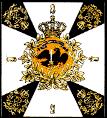
Bekanntmachung der Preussischen Armee
Dispatches of the Prussian
Army
Armeeschreiber
Courier Missing -- Presumed captured by the Imperial Guard Cavalry
SECOND ARMY OF THE WEST DISPATCH
I. MEMBERSHIP
Recruits continue to flock to the Tsar's service. Current active strength of the Second Army of the West is 47 officers, an increase of eight since the last dispatch. Of the new members, the following have completed training and received their command assignments:
7th Corps:
Podporuchik Alex Voduskii: 42nd Jagers Regiment, 3rd Brigade, 26th Inf Division.
Poruchik Pascal Hummel has returned to active service and has been assigned command of the
6th Jager Regiment, 12th Division.
8th Corps:
Podporuchik Zach Bogue: Siberian Grenadier regiment, 2nd Grenadier Division.
Podporuchik Philippe Mouledous: Little Russia Regiment, 2nd Grenadier Division.
Podporuchik Craig Stephens: Tarnopol Regiment, 27th Infantry Division.
Podporuchik Alan Lipa: Simbrisk Regiment, 27th Infantry Division..
4th Cavalry Corps:
Podporuchik Peter Prill: Litovski Lancers, 4th Cavalry Division.
Podporuchik David Vuyadinov: Novgorod Currassier Regiment, 4th Cavalry Division.
Militia (still in training):
Praporshik Alan Lipa: 1st Moscow Jager Regiment.
Praporshik Emil Aerne: 2nd Moscow Jager Regiment.
Praporshik Robert Banks: 3rd Moscow Jager Regiment.
Praporshik Max Khrapovitski: 1st Moscow Opolochnie Regiment.
Praporshik Marc Vuillet: 4th Moscow Opolochnie Regiment.
Resignations:
Poruchik Paul Buckingham has resigned his commission to return to his estates.
Pordpurchik Jarmo Larsson has resigned his commission due to personal obligations.
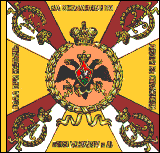
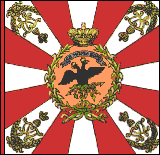
II. BATTLE HONORS/DECORATIONS/PROMOTIONS
R
ussian arms continued to enjoy success on the battlefield. Since the last dispatch, Russian officers have posted fourteen major victories and two minor victories:
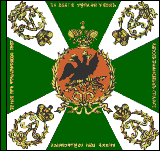
7th Corps:
Major Simon Ward:
Promoted to Major.
Awarded the Order of St. George in recognition of five victories in NIR scenarios.
Major victory in game #449.
Shtabs-Kapitan Ray White:
Promoted to Shtabs-Kapitan

8th Corps:
Major Chris Suttles:
Promoted to Major.
Promoted to the command of the 27th Division.
Admitted to the Guard and assigned honorary command of the Litovsk Lifeguard Regiment, First Lifeguard Division.
Awarded the coveted Order of Alexander Nevsky for his outstanding victory in which he destroyed the Grande Armee in the course of one morning.
Awarded the Order of St. George in recognition of five victories in NIR scenarios.
Major Victory in NIR scenario #10: Davout's Plan. The primary reason for the quick enemy capitulation was the movement of the Russian Imperial Guard and the First Army of the West's Cossack Corps to counter French reinforcements in the south. The Russians were able to trap and eventually destroy most of the enemy reinforcements, preventing the French from creating a possible bottleneck for Russian forces slowly retreating out of Utitza and onto the Utitza Mound. Elsewhere, the French were able to take two of the objectives in the fleches and the village across the Kolocha, albeit at very expensive costs. After several counterattacks the French line grew weak and the spirits of the Russian forces rose once news of the success in the south arrived. After hearing that, the Russian forces began pushing the French line steadily back reclaiming all but the Utitza objective. Napoleon, seeing his army destroyed, surrendered the field to our forces. French losses: 61,150 (I), 18,600 (C), 330 (A), 108 leaders worth 1,152 points including the capture of Marshal Ney near the fleches, Objective points- 200. Russian losses: 41,000 (I), 10,475 (C), 93 (A) and 26 leaders. Total points (-6446)
Major victory in game #582.
Major victory in game #440.
Major Jason Cawley:
Promoted to Major.
Awarded the Waterloo Medal in recognition of his major victory in a large BGW scenario.
Major victory in the historical Battle of Waterloo Scenario. The French surrendered the fight at dusk (34 turns completed), it being agreed at that point the French would not continue the struggle but would try to flee the field. One of the more curious events of the battle was the failure of Blucher personally to arrive at all, leaving the Prussian army with scattered leadership. The fighting was fierce at Hougemont through the early hours, with the chateau position never falling but the orchard changing hands several times. The French also attacked the Papelotte position, which also changed hands several times. Attacks on the ridge behind Papelotte were repulsed, with one brigade captured by Allied cavalry, and another routed by a flanking counterattack by British infantry. French cavalry reach the center hill of the Allied position and spiked many guns, but was quickly run off with considerable loss. Out west, the French drove the Dutch-Belgians far to the north, found themselves overextended, then recoiled from a counterattack led by General Hill. After 4 PM, the initiative passed to the Allies. Hill's attack continued, and was joined by Prussian pressure on French delaying forces in the northeast, and a determined Allied counterattack at Smohain and Papelotte, which cleared both. Then the whole allied line advanced, adding an attack at Hougemont and in the center. The French fell back to La Belle Alliance, and waged a protracted and skillful defense, while their flanks remained under heavy pressure. But French infantry losses had been too great, and Allied numbers told. By dusk, only 18,000 French infantry remained. Overall odds were nearly 3:1, when the French conceded and both agreed, the remainder would flee under the cover of twilight. Losses were heavy, but both sides protected their cavalry. The French lost 43,000 men (more than 1/2), while the Allies lost 28,000 (about 1/4). Detailed Losses - Allies - 21050 Inf, 4575 Cav, 93 Guns, 6 Ldrs French - 35775 Inf, 5000 Cav, 84 Guns, 20 Ldrs.
Kapitan Peter Green:
Promoted to Kapitan.

4th Cavalry Corps:
Generalmajor Peter Yrureta:
Awarded the Order of Franz Joseph in recognition of his 10th major victory.
Major victory in game #SPR249.
Major victory in game #471.
Podpolkovnik Juan Pablo Da Cruz:
Promoted to Podpolkovnik.
Promoted to the command of the 2nd Currassier Division.
Admitted to the Guard and assigned honorary command of the Horse Guard Regiment, First Cuirrassier Division.
Awarded the Order of St. Anne for his first major victory in a large NIR scenario.
Awarded the Order of Alexander Nevsky in recognition of the grievous casualties inflicted on the enemy in his latest victory.
Major victory in game CO92.
Major victory in game 424.
Major victory in game #479- NIR Scenario19: Advance the Guard. French Losses: 15,450 (I); 8,575 (C); 162 (A); 172 Leader points. Russian losses: 13,250 (I); 6,325 (C); 82 (A); 135 leader points.
Major Andy Lane:
Promoted to Major.
Awarded the Order of Alexander Nevsky in recognition of the grievous casualties inflicted on the enemy in his latest battle.
Major Joe Ayres:
Promoted to Major
Major victory in game #C055. French losses: 46,750 (I), 9,525 (C), 216 (A), 61 leaders. Russian losses: 29,125 (I), 16,060 (C), 61 (A) 24 leaders.
Major victory in game #338.
Podporuchik Konstantin Koryakov:
Awarded the General Service Medal in recognition of his first victory (10 turn minimum).
Major victory in game #512. French losses: 4,975 (I), 1575 (C), 12 (A), 2 leaders including the French commander Marshal Poniatowski. Russian losses: 1300 (I), 825 (C), 5 (A) and 2 leaders. All objectives held by the Russians.
Minor victory in game #568. French Losses: 6,675 (I); 1,200 (C); 6 (A); 5 Leaders. Russian losses: 5,475 (I); 475 (C); 64 (A); 2 leaders. All objectives held by the Russians.

Staff:
Polkovnik Karl Schneider:
Admitted to the Guard and assigned honorary command of the Preobrazhenski Lifeguard Regiment, First Lifeguard Division.
Minor victory in game #493- The Battle of Eckau (scenario #3 of the Napoleon in Russia NIR Battleground Project). The game involved a clash between Russian and Prussian forces in Latvia in the opening stages of the 1812 Campaign. Both sides had roughly 15,000 men. The Prussians had to cross a river running east-west to capture the 2 objective hexes on the Russian bank. Several bridges provided access across the waterway. The Prussians opened the action by securing several bridges before the Russians could reach and destroy the bridges. The Prussians sent strong detachments over the river in the center to pin the Russians. Meanwhile, a Prussian brigade of approximately 4000 men crept undetected over a bridge on the far Russian right. Fortunately for the Russians, ignorance truly is bliss. Totally unaware that a large Prussian force was flanking their position, the Russians commander concentrated almost his enitre foce on the Prussians in the center who had succeeded in crossing the river. The Russians brought their guns to almost point blank range and blasted the Prussians clinging to the riverbank. Combined cavalry and infantry attacks destroyed a large number of Prussians trapped with their backs to the river as the Prussian cavalry watched helplessly on the other bank. As the Russians mopped up the Prussian bridgeheads in the center, the Prussian flanking force burst forth on the Russian far right. The only Russian force in the area was a single battery and a thin jager screen. These meager forces delayed the Prussians just long enough for Russian reinforcements from the center to arrive. The scope of the Russian victory in the center allowed the Russian commander to send most of his men to counter this new threat. In the final turns, the Prussians almost reached the objective hexes but fire from several batteries succeeded in blunting the attack, which had no artillery or cavalry support. The Prussian brigade commander was captured in a final cavalry charge and surrendered his sword. Prussian losses: 8,075 (I), 700 (C), 0 (A), 1 leader. Russian losses: 3,900 (I), 225 (C), 1 (A) 1 leader.
Podpolkovnik Ruben Lopez:
Major victory in game #483- The Battle of Waterloo. The French Army surrendered after a bit more than four hours of battle. The French pressed hard all along the British front, but the red line held firmly and all the objectives were kept. Flanking attempts east and west ended in disaster for the French: Kellerman's Cuirassiers were completely eliminated and their command staff captured by the Netherlanders cavalry and infantry, plus Grant's Hussars. An attempt by the Imperial Guard cavalry and infantry to pass through the woods east of Smohain was repulsed with heavy losses. The Guard cavalry also tried to break the British center, but the Empress Dragoons and the Grenadiers á Chevaux were surrounded and captured by the British and Brunswicker cavalry. The Prussians started to arrive about 2:00 PM, although only the 15th Infanterie-Bde and some cavalry units. But that threat in the French right flank plus the pressure by the Netherlanders in their left was enough to convince the French command of the futility of their efforts. At 3:30 PM they surrendered the field. The British forces being very fatigued and having arrived but a few Prussians, we didn't pursue the enemy and were contented with our victory.
French losses: 18,575(I), 8,975(C), 80 (A), 25 leader casualties: Captured (14):
Génerals de Div. D'Hurbal, L'Heritier, Guyot, Lallemand
Génerals de Brig. Donop, Wathiez, Picquet, Guiton, Gobrecht, Jamin, Cambronne, Three colonels; Killed and Wounded (11): Génerals de Div. Kellermann, Delort
Génerals de Brig. Huber, Quiot, Blancard, Vinot,
Five colonels
Allied losses: 14,325(I), 2,350(C), 41(A), 13 leader casualties: Killed (8): Maj.-Gen. Adam, Maj.-Gen. Halkett, Maj.-Gen. Kielmansegge, Lt.-Gen. Kempt, Col. Du Plat, Col. Halkett and two colonels. Wounded (5): Maj.-Gen. Von Kruse, Maj.-Gen. Vivian, Maj.-Gen. d'Aubreme, Maj.-Gen. Olfermans and one colonel.
LONG LIVE THE TSAR!
Polkovnik Karl Schneider
Chief of Staff
Second Army of the West
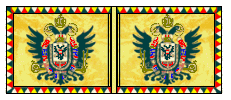
Austrian Army News
The army made a deadly lunge at the enemy during this period and several victories were posted by our officers. Of honorable mention was Oberst Quigley who won a Major Victory over his French advesary.
The Vienna Military Academy has graduated Stephane Chicouri and also Scott Cheatham. Both of these officers are out looking for Frenchmen to fight!
It is hoped that the upcoming Spring Maneuvers will see our army rise up and put up a good fight with their Prussian, Anglo-Allied and Russian counterparts. Long live the Kaiser and the army!
Bill Peters
ArchDuke Bill Peters,
Austrian CoA
[Editor's Note: About a month after this dispatch was received, Bill Peter's announced his resignation from the NWC. Bill was an integral part of the club and the allied coalition. His services and friendship will be greatly missed. We wish him the best and hope to see him return someday. P.S. Rumor has it that Archduke Karl has returned rather than see his much beloved army disperse.]
The Front Page | Feature Articles | Strategy and Tactics | Regimental Histories | Dispatches | Letters to the Editor
There is a heck of a lot of stuff our there on the web for those interested in Napoleon and the Napoleonic Wars. More than we can possibly put in the newsletter. A few of the more interesting sites that we have come across are described below. We encourage members to share their favorite sites as well (just drop one of us a line). KJ
The Front Page | Feature Articles | Strategy and Tactics | Regimental Histories | Dispatches
If you have something to contribute or would like comment on any aspect of the newsletter or the NWC, then feel free to write a letter to the editor (
kenjones@va.prestige.net). However, this newsletter reserves the right to ignore, edit, delete and/or refuse to publish any letter received if it is deemed to be inappropriate or worthless. All letters absolutely must include the name of the author and his/her e-mail address or they will not be posted. KJ
The Front Page | Feature Articles | Strategy and Tactics | Regimental Histories | Dispatches

He Rests ...